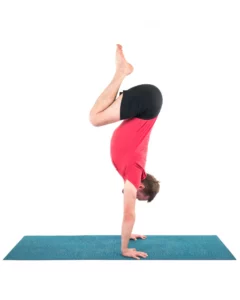Left Brain, Right Brain: Yoga’s Balancing Breath Practices

Did you know that you don’t breathe from both nostrils equally? Truth be told, nostril dominance switches every two to 2.5 hours without our interference. Sounds strange, but scientists have studied this phenomenon, which the yogis discovered hundreds of years ago. In 1895, a German physician, Richard Kayser, observed these periodic cycles, which scientists call “nasal cycling.” Interesting, but does it matter? Multiple research studies indicate that nasal cycling is related to how our bodies function. We can also employ yoga breath practices to help us maintain a balance between the two sides.
Breath and the Nervous System

Our central nervous system is comprised of two parts: the sympathetic nervous system (SNS), nicknamed the “fight-or-flight” response, and the parasympathetic nervous system (PNS), or “rest-and-digest” response. According to scientists, we have sympathetic dominance at any given moment on one side of the body (and breathe mostly through that nostril) and parasympathetic dominance on the other. This switches throughout the day, affecting both bodily functions and energy levels.
When the sympathetic system is dominant on the right side and the parasympathetic on the left side, we enter a more active, stimulated state, and the following are true:
- Right nostril and lung dominance
- Increased locomotor activity
- Increase in heart rate, blood pressure, respiration, and body temperature
- Increased levels of cortisol, testosterone, and endorphins
On the other hand, when the sympathetic system is dominant on the left side, the body assumes a more restful state. Not only are the left nostril and lung more dominant, but all the things listed above—heart rate, cortisol levels, etc.—decrease. Understanding how the breath affects each part of the nervous system enables us to have some influence over it.
Yoga Breathing Practices and the Solar and Lunar Channels

According to yogic tradition, nostril dominance influences the flow of energy in our body. For example, when breathing through the right nostril, we activate our pingala nadi or solar channel. The solar channel stimulates the more “masculine” functions of the brain. Left brain dominance is associated with analytical, verbal, and orderly qualities. Further, it stimulates the sympathetic nervous system, giving us a boost when tired, lethargic, or depressed, and aids digestion.
By contrast, breathing through the left nostril activates the ida nadi or lunar channel. Associated with the “feminine” functions of the brain, right brain functioning tends to be more visual and intuitive. Nicknamed the “analog brain,” right-brain dominant people frequently excel at creative, non-linear tasks and holistic thinking. Because it stimulates the parasympathetic nervous system, left-nostril breathing produces a soothing and calming effect on the mind and body. The graphic below provides a summary of the differences between brain hemisphere functions:

Of course, bisecting the body as male and female is not intended to suggest that women cannot be logical or assertive or men can’t be nurturing or intuitive. Rather, it reminds us that all humans are made of both the sun and the moon—the masculine and the feminine. Yogis believe that we all possess a mix of these qualities. As such, one of the goals of yoga is to bring balance between these forces.
3 Balancing Breath Practices

While asanas that emphasize cross-body movements provide one path for balancing the solar and lunar energies, so does pranayama. If you’ve practiced yoga for a while, you are probably familiar with Nadi Shodhana, which is alternate nostril breathing. Yogis frequently practice Nadi Shodhana prior to meditating to calm and focus the mind. In addition, this breathing technique balances the brain hemispheres and harmonizes the body’s masculine and feminine energies.
The practice of Chandra Bhedana, or moon breathing, calms the nervous system. It’s often used to promote sleep. Chandra Bhedana reduces body heat, lowers blood pressure, steadies the mind, and reduces mental tension.
On the other hand, to bring more heating and stimulation, try sun breathing or Surya Bhedana. Surya Bhedana is warming and nourishing and can be used to relieve depression, low energy, and fatigue.
While these pranayama practices usually involve hand mudras, or gestures, to direct the flow of the breath, I often teach it using only awareness.
Breath Practices: Chandra Bhedana and Surya Bhedana

- Sit in a comfortable seated position with a straight spine.
- Close your eyes and focus your attention on your natural breath for 2 to 3 cycles.
- As you feel ready, begin to lengthen your inhalations and exhalations, coming to a ratio of about a four-count inhalation and a six-count exhalation. If you feel short of breath, back off and try a lower ratio, such as two counts in and three counts out. Stay with your chosen ratio for three to four breath cycles. Feel free to continue with the ratio or not as you proceed to step 4.
- Next, bring awareness to your left nostril. Visualize inhaling through your left nostril and exhaling through the right. Don’t worry if, at first, you don’t feel the breath moving in through the left and out the right. Stick with the practice for at least 5 to 6 cycles of breath or 1 to 2 minutes.
- Release the practice and allow your breath to return to its natural pattern. Observe any sensations or aftereffects.
For Surya Bhedhana, follow the same directions, inhaling instead through the right nostril and exhaling through the left.
While nostril dominance shifts independently throughout the day, knowing how to use the body’s sun and moon channels is a powerful tool for managing energy and mood. Explore these practices for yourself and notice how your breath acts as a mirror of your inner landscape.
Also, read...
Warrior I Pose: 5 Strengthening Variations
Jul 02 – Bridget Frederick, eRYT 500
Deepening Your Home Yoga Practice: An Interview with Judith Hanson Lasater
Jun 30 – staff writer YogaUOnline
4 Easy Ways to Use a Sandbag in Yoga Practice
Jun 18 – Jennifer Williams-Fields E-RYT 200
Related courses
Breath as Medicine: Yogic Breathing for Vital Aging
With Doug Keller
Yoga and Myofascial Release: Releasing Chronic Tension with the Bodymind Ballwork Method
With Ellen Saltonstall
Yoga and Detoxification: Tips for Stimulating Lymphatic Health
With Lisa Levitt Gainsley

Beverly Davis-Baird, MA, e-RYT200/RYT 500, C-IAYT is a New Jersey-based yoga therapist, writer, and educator. She specializes in making yoga accessible for adults 50+, offering classes and workshops for back care, arthritis, bone health, balance, posture, and healthy aging. An educator at heart with over 20 years of experience as a public school teacher, Beverly brings her knowledge of individual learning styles to her classes, providing instruction that is clear, concise, inclusive, and compassionate. Bringing over 30 years of experience and training, she considers herself a lifelong learner and believes that the practice of yoga should bring spaciousness and release from tension, not create it. As such, she strives to make yoga accessible to people of differing abilities, believing the real benefits of yoga come from what is taken with you outside of class and into your life. To read her blog or learn more about her teaching schedule and latest offerings, please visit www.wisdomtreeyoga.com.
Recent articles
Fascia and the Vagus Nerve: Healing from the Inside Out
Jul 10 – Dr. Arielle Schwartz
Change Your Perspective of Pelvic Tilting: How the Transversus Abdominis Can Help
Jul 08 – Olga Kabel C-IAYT
Warrior I Pose: 5 Strengthening Variations
Jul 02 – Bridget Frederick, eRYT 500
Categories
Upcoming courses
Breath as Medicine: Yogic Breathing for Vital Aging
With Doug Keller
Yoga and Myofascial Release: Releasing Chronic Tension with the Bodymind Ballwork Method
With Ellen Saltonstall
JOIN NOW!
Recent articles
Almost there...
Sorry, we couldn't find anything...
Stress Relief
Fascia and the Vagus Nerve: Healing from the Inside Out
Have you ever had a morning in which you woke up with a painful…
Jul 10 – Dr. Arielle Schwartz
Pose Library
Change Your Perspective of Pelvic Tilting: How the Transversus Abdominis Can Help
“Tuck your tailbone under” or “lengthen your tailbone” have long been among the most…
Jul 08 – Olga Kabel C-IAYT
Yoga Practice Tips
Warrior I Pose: 5 Strengthening Variations
Warrior I Pose (Virabhadrasana I) is an excellent pose for strengthening your whole back…
Jul 02 – Bridget Frederick, eRYT 500



